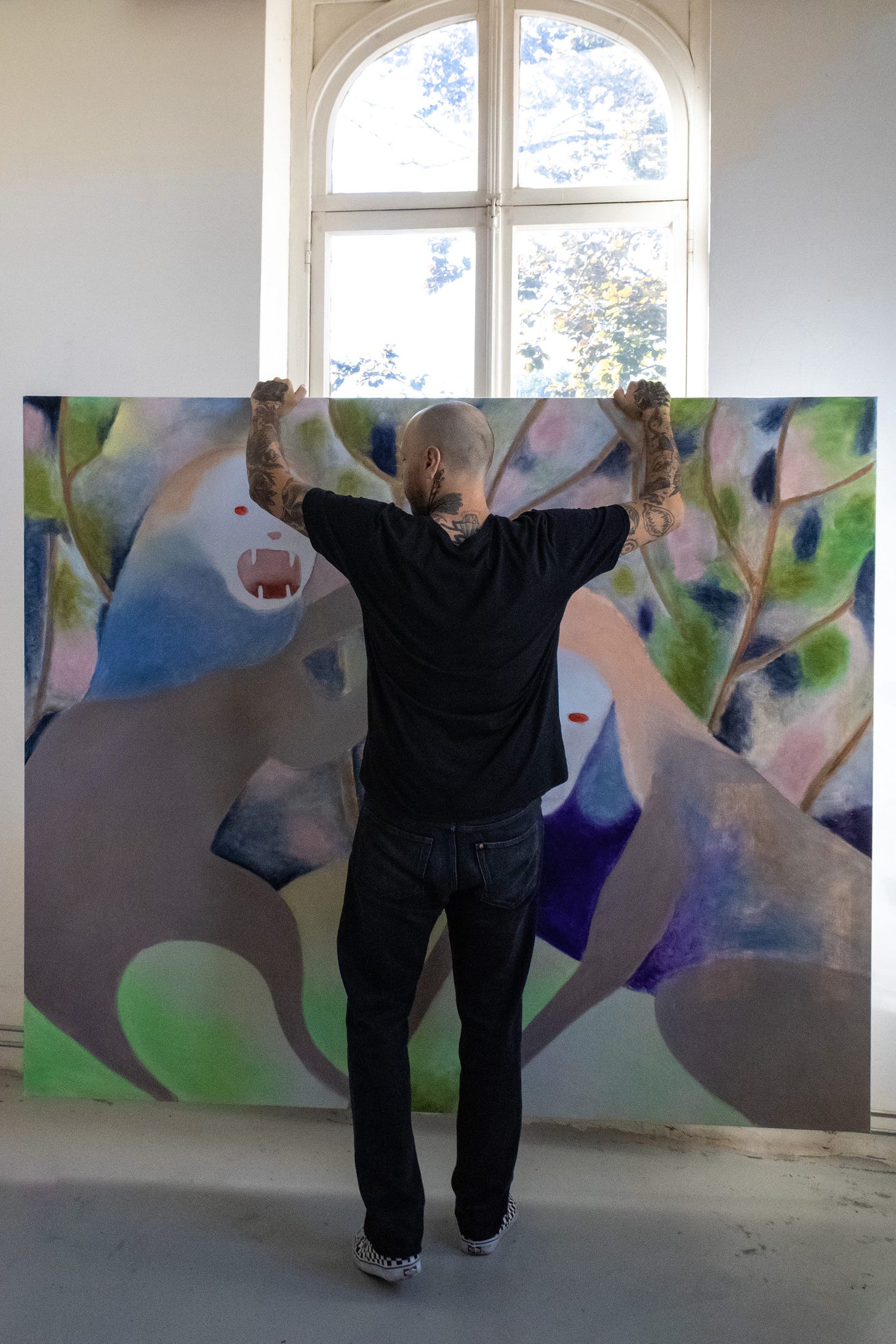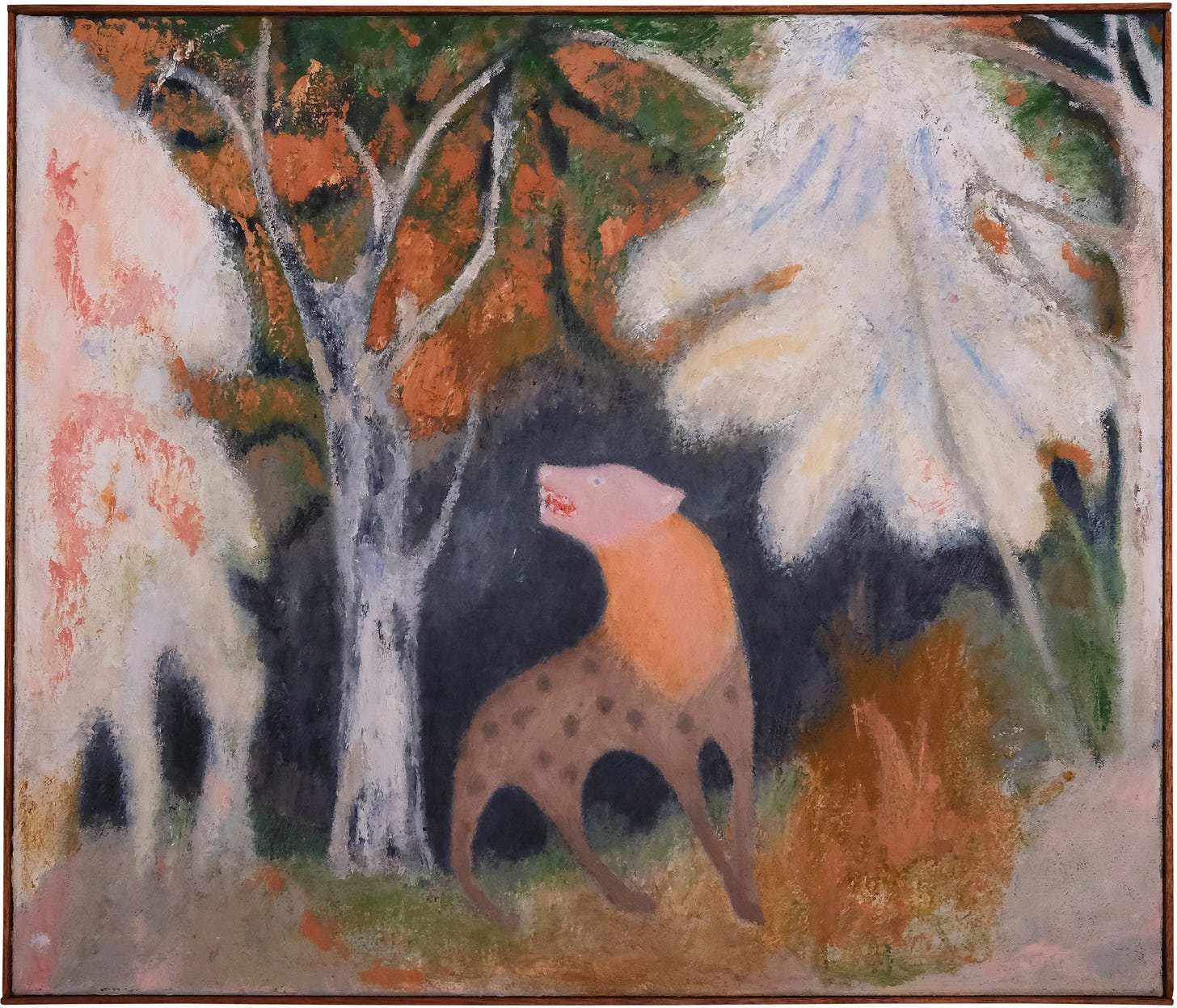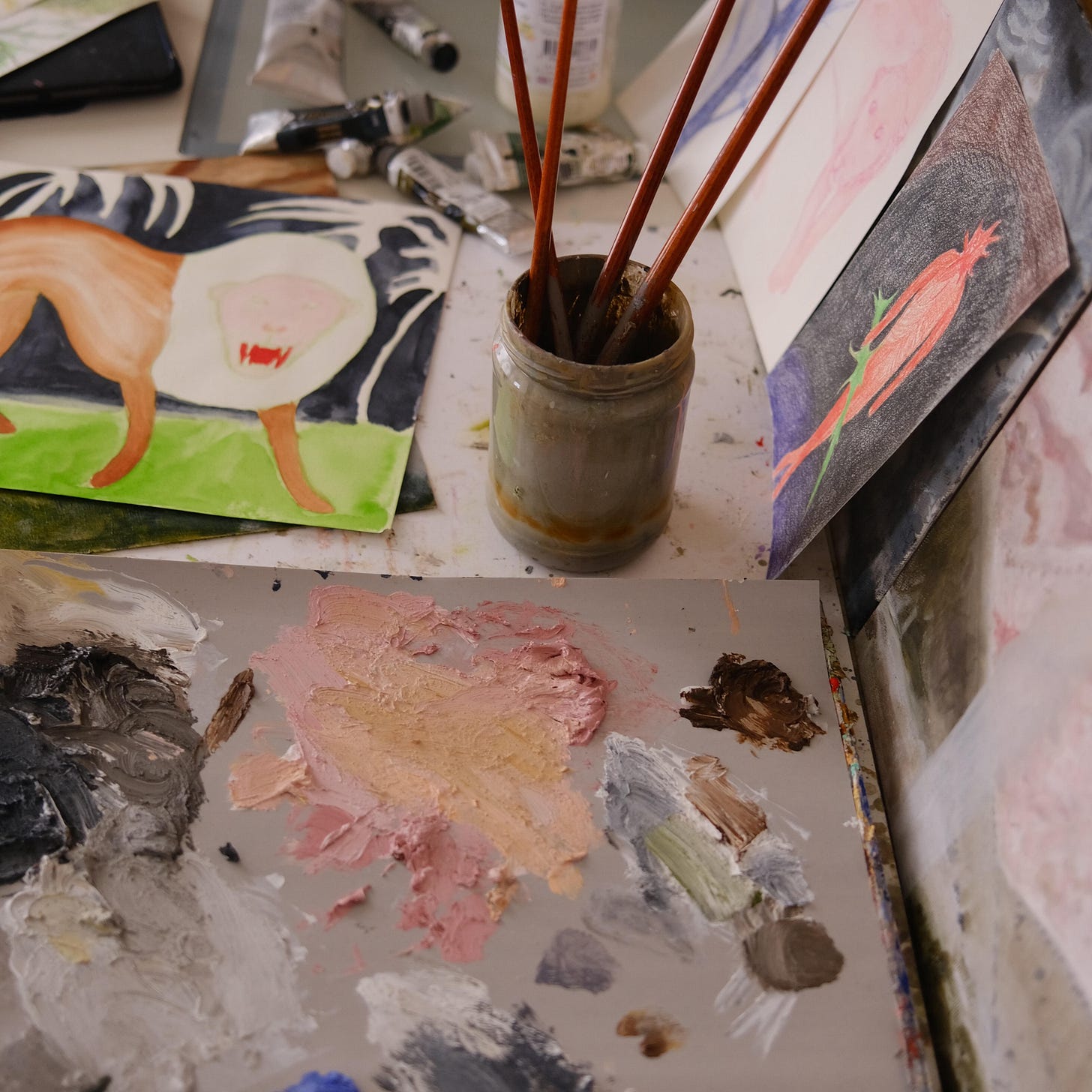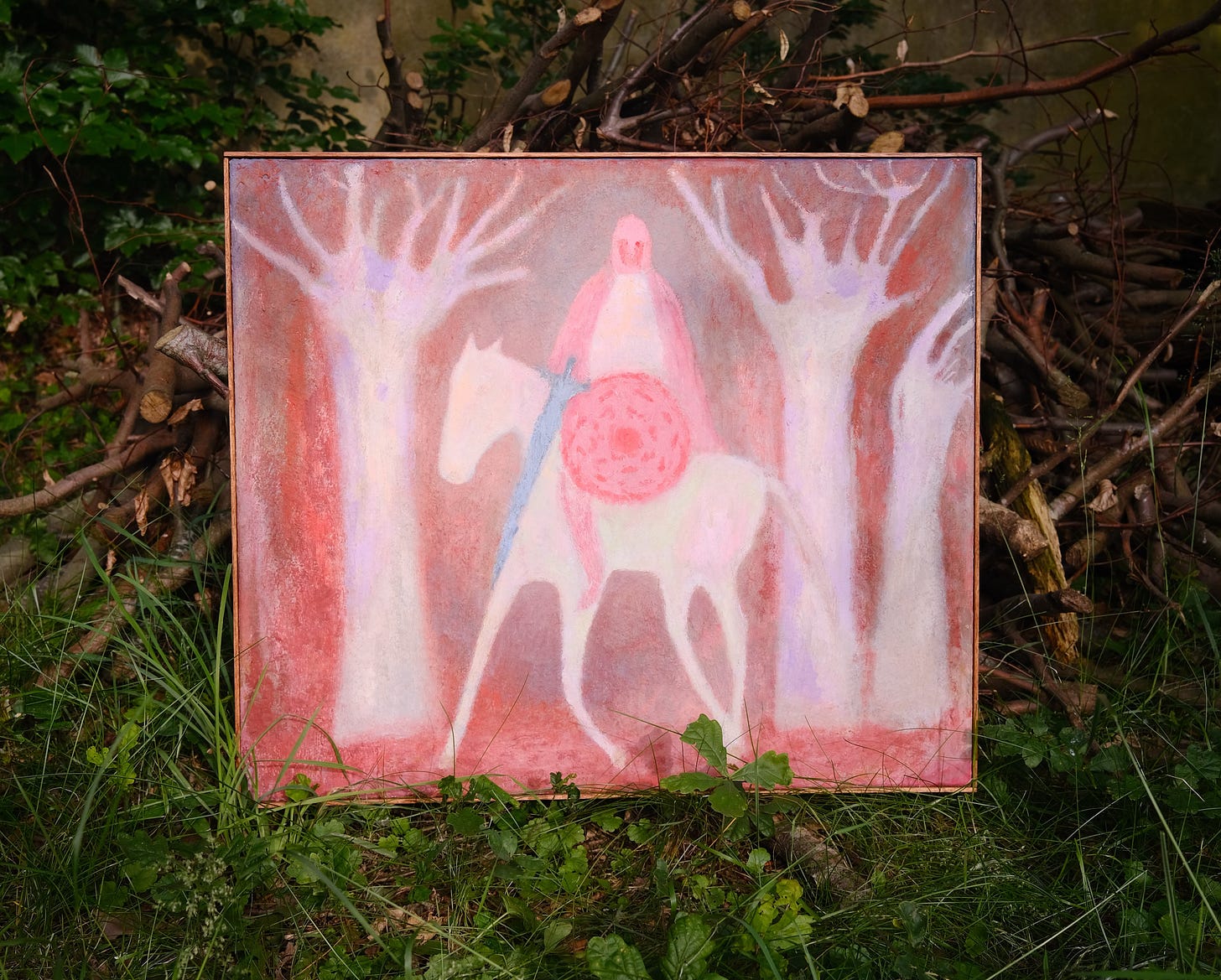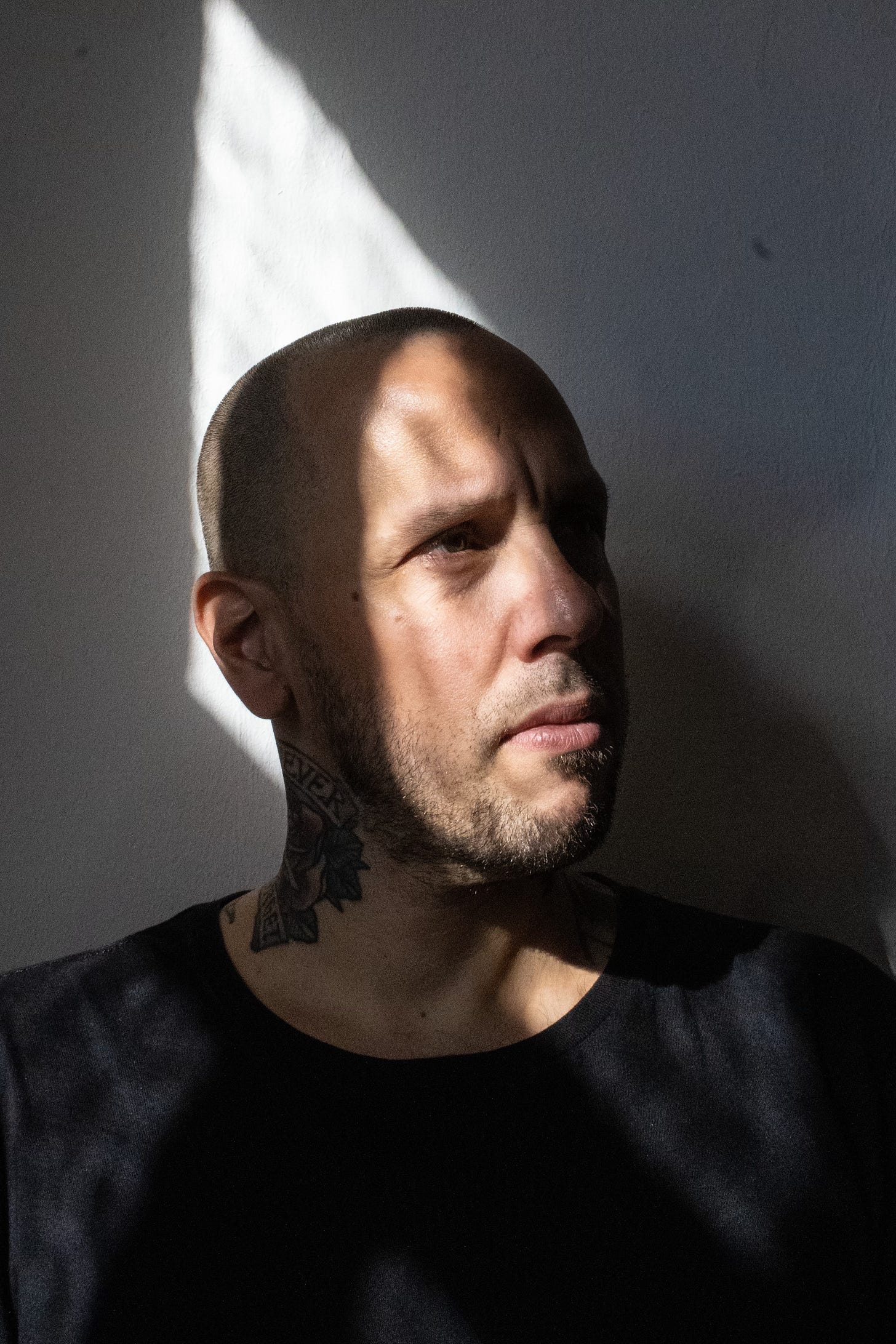Guy Rubicon
The self-taught Belgian painter spoke with me about his background as a tattoo artist and his transition to becoming a professional painter
For the upcoming group show Stray Passages on mepaintsme.com, Guy Rubicon continues his theme of mankind’s tenuous existence vs. the natural world by painting ghostly forests inhabited by beasts and ambiguous figures on horseback. Selected recent exhibitions include solo shows at Hioco Delany Gallery, Antwerp, Belgium and HAGD Contemporary, Denmark; and a duo show at Saint Cloche Gallery in Sydney, Australia.
MEPAINTSME: You have an interesting background. You studied photography and have also been a tattoo artist for many years. What was it that first got you into painting?
Guy Rubicon: I became very interested in tattooing during my studies as a photographer. I tried to become a professional photographer after my studies, but that didn’t work out, so I put all my energy into trying to become a tattooer. I would work late shifts in factories and paint tattoo flash at night, and I would practice tattooing on my friends and my brothers on the weekends; I did that for two years until I opened a tattoo shop. As a tattooer, I always loved making flash and experimenting with the different mediums I found at the art stores. The tattoo flash I made often became little works of art for me, the designs not necessarily meant to be tattooed, but just stuff that I thought looked cool. When I started to mess around with oil paint, I immediately fell in love with it, although it took several years to learn the formal techniques and to understand its possibilities; I’m still learning.
Over the last few years I’ve been taking painting more seriously, I think because of the freedom it offers compared to tattooing. A tattoo is always a compromise between the artist and the customer; and there are more restrictions than in painting. The great thing about tattooing is that you get to be creative everyday, so it’s a small step to try something different like oil painting. The downside of having been a tattooer for almost 20 years, is that tattooing is all about control, To execute a good tattoo you need to know exactly what you are doing, and follow the right steps from start to finish. Painting is somewhere halfway between control and chaos I think, and I’m still learning to let go of the control and embrace the chaos.
MPM: I see this conflict and balance between control and chaos in your work. I also see an influence from tattooing — your subjects are often singular and iconographic, as well as symbolic. Do you see this too? Is this a conscious approach?
GR: I definitely understand this. I think tattoo art is as old as humankind; we’ve tattooed each other for thousands of years. Tattoo art often depicts animals and totems, sometimes deceptively simple in their design, just like folk art. What I’ve always loved about a lot of tattoo art is the way it’s stripped of everything unnecessary to become an iconic symbol that expresses simple but powerful concepts like life, freedom, death, beauty, family, etc... I see this, too, in prehistoric art — it’s almost always animals or human figures with spears and swords. Those cave drawings are so good, there’s no way you can draw a horse or a buffalo like that without thousands of hours of practice. Maybe they practiced on each other’s skin, who knows…?
MPM: Your surfaces appear to be fantastically rich. I really enjoy your paint quality. Can you speak a bit to your process?
GR: I’ve been experimenting with texture over the last year, I’ve tried sand and pumice in the gesso. It makes the surface very gritty and harder to paint over, so you lose some control, and I like that! I’ve also tried beeswax mixed with oils and pigment. It gives nice texture to the paint and it helps me to paint more freely and loose.
MPM: You often implement rich and vivid color. It seems to feed your dreamlike scenes and imbue them with a foreboding danger. What is your relationship with color?
GR: I’m very much drawn to color. I remember as a kid, I would love a movie or a cartoon just because of the colors. If it had a boring color palette, I would lose interest. Color has a deep emotional and spiritual effect in art and nature. I remember seeing a couple of Van Gogh’s in a museum in Paris for the first time, there where 20 other paintings from other artists in that room, but somehow I could only see the Van Gogh’s. Their colors smacked me in the face, they completely drew me in.
MPM: Two common motifs you represent are carnivorous animals and the warrior (or guardian?) figure. Do you see them as protectors or antagonists?
GR: I often imagine what it would have been like to have lived thousands of years in the past, to be in a forest and all of a sudden come across a huge panther or a sabertooth tiger; or a warrior on a horse with a shining sword that you have never seen before. It must have been terrifying to live in a world like that, but it was our reality for millennia, for a far longer time than this modern world in which we are living in now. The world has changed, but we are still the same. Now it’s not the one with the biggest sword, but the one with the biggest army who has the most power. The human figures and animals in my paintings, I don’t consider them good or bad, they are indifferent, like nature is indifferent. The wolf and the tiger that I admire for their beauty and grace and power, are also ruthless killers. The same goes for the warrior figures. I think they represent the violence we all have in us — we see it happening today, a war-hero to some is a war criminal to others. It has always been like this.
MPM: Your work feels imagined, but rooted in the natural world. Do you spend a lot of time in nature?
GR: The natural world has always been important to me. I’m not a religious person, but being in nature is definitely a spiritual experience for me. We are connected to every living thing, all life evolved from one common ancestor, that’s a wonder to me. I always thought I was an atheist, but maybe I’m a pantheist. I don’t know, it depends on the day. I live in an area in the east of Belgium that’s dotted with old coal mines and nature reserves and I’m lucky to have the forest and its nurturing, healthy environment just around the corner. I’m fascinated by the patterns and the shapes of nature, the leaf of a dandelion almost looks like a sword from some lost civilization. And a dying sunflower looks so beautiful and creepy at the same time. There are so many beautiful abstract shapes even in the flowers and leaves and branches in my own backyard.
MPM:Do you still do tattoo art?
GR: I haven’t made any tattoo flash in a couple years, but I’m going to make one soon for the anniversary of a friend’s tattoo shop. I’m looking forward to making a sheet of flash again and am curious to see if my painting practice will have any influence on the way the flash will turn out.
MPM: When you're in the studio do you work with music or silence? Podcasts? What are you currently listening to?
GR: Almost always with music, sometimes silence, but I would say 95% of the time loud music. Lot’s of African music lately: the Tuareg musician Mdou Moctar is on heavy rotation, also the Congolese superstar Tabu Ley Rocherau, Ebo Taylor from Ghana. I listen to a lot of different music, from Hank Williams to Lee Perry. Anything with soul.
Guy Rubicon is one of four artists featured in the forthcoming exhibition Stray Passages, curated by MEPAINTSME and on view from June 12 - July 17, 2024.


